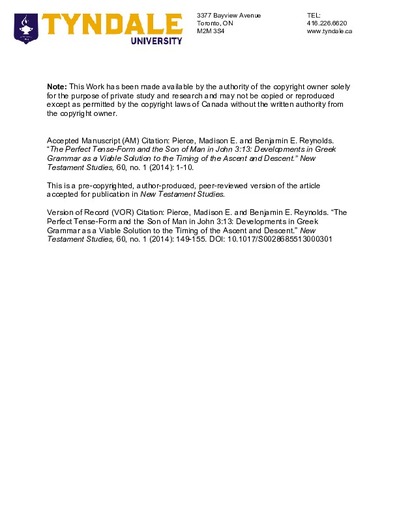| dc.rights.license | Attribution-NonCommercial-NoDerivatives 4.0 International License | en_US |
| dc.contributor.author | Pierce, Madison N. | |
| dc.contributor.author | Reynolds, Benjamin E., 1977- | |
| dc.date.accessioned | 2023-02-02T18:32:44Z | |
| dc.date.available | 2023-02-02T18:32:44Z | |
| dc.date.copyright | 2014 | |
| dc.date.issued | 2014 | |
| dc.identifier.citation | Accepted Manuscript (AM) Citation: Pierce, Madison E. and Benjamin E. Reynolds. “The Perfect Tense-Form and the Son of Man in John 3:13: Developments in Greek Grammar as a Viable Solution to the Timing of the Ascent and Descent.” New Testament Studies, 60, no. 1 (2014): 1-10. | en_US |
| dc.identifier.issn | 0028-6885 | en_US |
| dc.identifier.uri | https://digitalcollections.tyndale.ca/handle/20.500.12730/2185 | |
| dc.description.abstract | The perfect tense-form verb ἀναβέβηκεν in John 3.13 is usually interpreted in light of traditional verb theory, as a “past action with present results”. This interpretation introduces an apparent problematic chronology in that the Son of Man ascends before descending; however, recent developments in Greek grammar, particularly verbal aspect theory, provide a viable solution to this grammatical “problem” and indicate that the Son of Man’s descent precedes his ascent. | en_US |
| dc.format.medium | Paper | en_US |
| dc.format.mimetype | application/pdf | en_US |
| dc.language.iso | en | en_US |
| dc.publisher | Cambridge University Press | en_US |
| dc.rights | Copyright, Cambridge University Press. All rights reserved. | en_US |
| dc.rights.uri | https://creativecommons.org/licenses/by-nc-nd/4.0/ | en_US |
| dc.subject.lcsh | Jesus Christ--Chronology | en_US |
| dc.subject.lcsh | Bible. John | en_US |
| dc.subject.lcsh | Greek language--Grammar | en_US |
| dc.subject.lcsh | Son of Man | en_US |
| dc.title | Perfect Tense-Form and the Son of Man in John 3.13: Developments in Greek Grammar as a Viable Solution to the Timing of the Ascent and Descent | en_US |
| dc.type | Article | en_US |
| dc.contributor.affiliation | Tyndale University College & Seminary | en_US |
| dc.contributor.department | Department of Biblical Studies and Theology (Reynolds) | en_US |
| dc.contributor.repository | Tyndale University, J. William Horsey Library, 3377 Bayview Ave., Toronto, ON, M2M 3S4, Canada. Contact: repository@tyndale.ca | en_US |
| dc.identifier.bibrecord | https://tyndale.on.worldcat.org/oclc/1713962 | en_US |
| dc.identifier.doi | 10.1017/S0028688513000301 | en_US |
| dc.identifier.issue | no. 1 | en_US |
| dc.identifier.journal | New Testament Studies | en_US |
| dc.identifier.orcid | https://orcid.org/0000-0001-8389-7148 (Reynolds) | en_US |
| dc.identifier.orcid | https://orcid.org/0000-0003-4242-9107 (Pierce) | en_US |
| dc.identifier.volume | 60 | en_US |
| dc.publisher.place | Cambridge, UK | en_US |
| dc.relation.isversion of | Version of Record (VOR) Citation: Pierce, Madison E. and Benjamin E. Reynolds. “The Perfect Tense-Form and the Son of Man in John 3:13: Developments in Greek Grammar as a Viable Solution to the Timing of the Ascent and Descent.” New Testament Studies, 60, no. 1 (2014): 149-155. DOI: 10.1017/S0028685513000301 | en_US |
| dc.rights.holder | Cambridge University Press, University Printing House, Shaftesbury Road, Cambridge CB2 8BS UK information@cambridge.org | en_US |
| dc.subject.keyword | Jesus Christ--Chronology | en_US |
| dc.subject.keyword | Bible. John | en_US |
| dc.subject.keyword | Bible. John 2-4 | en_US |
| dc.subject.keyword | Bible. John 3:13 | en_US |
| dc.subject.keyword | Verbal aspect theory | en_US |
| dc.subject.keyword | Greek grammar | en_US |
| dc.subject.keyword | Son of Man | en_US |
| dc.subject.keyword | Ascension | en_US |
| dc.subject.keyword | Descent | en_US |
| dc.description.chapterpage | 1-10 | en_US |
| dc.description.note | For AODA accommodation, including help with reading this content, please contact repository@tyndale.ca | en_US |
| dc.description.version | Accepted Manuscript | en_US |


